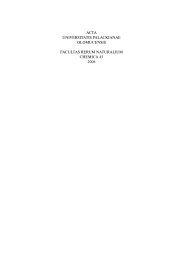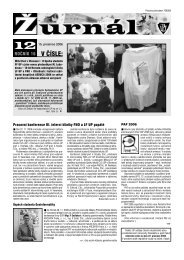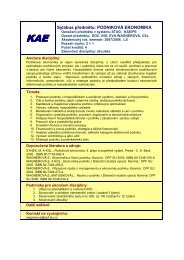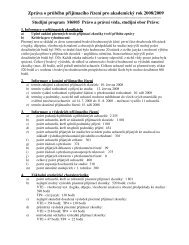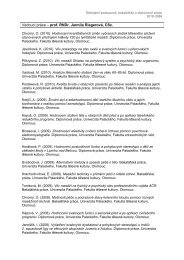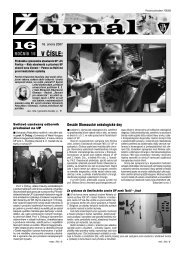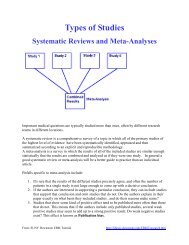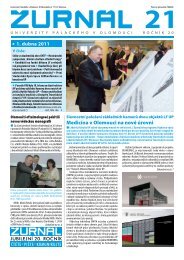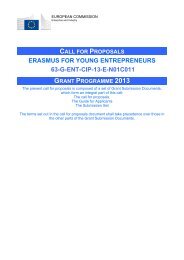56 Acta Univ. Palacki. Olomuc., Gymn. 2004, vol. 34, no. 2respiration frequency and a higher level of inspirationand expiration muscle activation. Decrease of respiratoryfrequency led to a shift of frequency componentbound to respiration that we regard as vagus activity inthe spectral field in the sphere of LF frequency component.According to Paleček et al. (1999), intensifyingrespiratory volume infl uences pressure proportion inthe lungs and reflectively stimulates total vagus activity.When compared to spontaneous respiration, we foundsignifi cant enhancement of total spectral power, thatwe regard as the demonstration of total activity of theautonomous nervous system. Respiratory bound vagusactivity moved during bradypnoe into the sphere ofthe LF frequency component, mainly participating inthe enhancement of total spectral power. Respiratorybound vagus activity, respectively frequency and amplitudechanges are influenced by the relationship betweenrespiratory frequency and volume. Their dominant frequencyin the zone of the HF frequency componentwas not bound in this case to respiration and its sourceis still unclear. The influence of the activity of other innerorgans, parasympathetically directed, comes underconsideration. There is also the probability that thedominant frequency in the HF zone is a harmonic frequencyinfluenced by a frequency shift of the dominantfrequency bound to respiration.Respiring alternatively through the right and leftnostrils (the technique of anuloma viloma) was linkedwith a decrease in respiratory frequency, enhancementof respiratory volume and partial enhancement of upperairways resistance when compared to spontaneousrespiration. According to empirical experience, this respiratorytechnique is regarded as a so-called harmonisedrespiration technique, leading to a subjective feeling ofmental calming when applied. This technique presenteditself within the results of the spectral analysis of heartrate variability as a non-significant enhancement of totalspectral power, a decrease in spectral power in the zoneof the VLF frequency component and, at the same time,an enhancement of spectral power in the sphere of LFand HF frequency components. The spectral power ofthe LF frequency component was very probably modulatedby a shift of respiratory bound parasympatheticactivity during the slowing of respiratory frequency toless than 9 cycles/min. from the HF zone during spontaneousrespiration into the LF zone during applicationof this technique. Compared to spontaneous respirationit is possible to understand this technique specifically asrelaxation and as a regenerative technique that increasesthe share of parasympathetic activity in the total ANSactivity.The kapalabhaty technique consists of shallowrapid diaphragm breathing with a frequency of about120 cycles/min. During this respiratory technique we observeda significant reduction in the total spectral powerand a concurrent reduction in the spectral powers in allthree partial spectral components. Respiratory boundvagus activity shifted during the use of this techniqueabove the upper frequency zone of 0.4, respectively0.5, Hz and its frequency, we suppose, regarding theaverage respiration frequency of 107.4 cycles/min. in theproximity of 1.79 Hz. The picture of SAHRV changesduring this technique is a reflection of a specific stresssituation characterised by a higher share of sympatheticactivity regulating cardiac activity. The origin of lurkingfrequency activity in the zone of HF frequency componentthat is not bound to respiration is still unclear. Theorigin of these frequencies in the HF zone we probablysee as activity that is modulated by signals from otherinner organs innervated by the vagus nerve.CONCLUSIONS• Respiratory pattern is a fundamental factor that objectivelyinfluences the actual functional activity ofthe autonomous nervous system and increases theextent of vagus activity in its total activity.• Respiration frequency actually influences the positionof respiratory bound frequency that we regardas vagus activity. The position of respiratory boundvagus activity can be expressed by the numericrelation RvFr (mHz) = 0.0167 × Rf/min. duringexamination by SAHRV method. (Question no. 1,confirmation of hypothesis no. 1.)• Rhythmisation of respiration, respectively stabilityof respiratory frequency and stability of respiratoryvolume, stabilises the frequency and amplitude ofrespiratory bound vagus activity.• During bradypnoe with a respiratory frequency ofless than 9 cycles/min., a shift of respiratory boundactivity happens, from the HF frequency componentinto the zone of the LF frequency component. Respiratorybound vagus activity, under these conditions,becomes the dominant frequency in the zone of theLF component. (Confirmation of hypothesis no. 3.)• An increase in respiratory volume during the useof the bradypnoe technique of full yoga breathincreases signifi cantly the amplitude modulation(spectral power in ms 2 ) of respiratory bound vagusactivity. Enhancement of ANS activity with a higherdominance of parasympathetic activity is the effectof this type of respiration. (Confirmation of hypothesesno. 2, 4.)• The so-called technique of kapalabhaty (tachypnoe)can be regarded as a specific type of physical loadthat decreases markedly the variability of R-R intervals.• Frequency activity in the zone of the HF frequencycomponent during use of the kapalabhaty techniquewhen the frequency shift of respiratory bound vagus
Acta Univ. Palacki. Olomuc., Gymn. 2004, vol. 34, no. 2 57activity out of the registered frequency spectrum isregarded as activity in the HF zone that is not boundto respiration as an activity originating probablyfrom parasympathetically directed signals from innerorgans. (Confirmation of hypothesis no. 5.)REFERENCESAkselrod, S., Gordon, D., Madwed, J. B., Snidman, N.C., Shannon, D. C., & Cohen, R. J. (1985). Hemodynamicregulation: Investigation by spectral analysis.American Journal of Physiology, 18, 867–875.Akselrod, S., Gordon, D., Ubel, F. A., Shannon, D. C.,& Cohen, R. J. (1981). Power spectrum of heart ratefluctuations: A quantitative probe of beat-to-beat cardiovascularcontrol. Science, 213, 220–223.Baštecký, J., Šavlík, J., & Šimek, J. (1993). Psychosomatickámedicína. Praha: Grada – Avicenum.Benson, H., & Starková, M. (1997). Moc a biologievíry v uzdravení (Černý, V. A., Trans). Praha: Práh.(Original work published 1996).Brown, T. E., Beightol, L. A., Koh, J., & Eckberck, D. L.(1993). The important infuence of respiratorion onhuman R-R interval power spectra is largely ignored.Journal of Applied Physiology, 75, 2310–2317.Cacioppo, J. T., Bernston, G. G., Binkley, P. F., Quigley,K. S., Uchino, B. N., & Fieldstone, A. (1994).Autonomic cardial control. II. Basal response,noninvasive indices, and autonomic space as revealedby autonomic blockades. Psychophysiology,31, 586–598.Dostálek, C. (1996). Hathajóga. Praha: Karolinum.Dostálek, C., & Krása, H. (1976). Vliv dechovéfáze na tvorbu podmíněného refl exu u člověka.Československá psychologie, 18, 401–410.Dylevský, I., Druga, R., & Mrázková, O. (2000). Funkčníanatomie člověka. Praha: Grada.Fabián, Z., Lepičovská, V., & Dostálek, C. (1982). Onthe analysis of quasiperiodical changes in EEC andrespiration during breathing exercises. Acta Nerv.Super., 24(3), 173–174.Frostel, C., Pande, J. N., & Hedenstierna, G. (1983).Effects of high-frequency breathing on pulmonaryventilation and gas exchange. Journal of AppliedPhysiology, 55(6), 1854–1861.Ganong, W. F. (1999). Přehled lékařské fyziologie. (J.Berger a kolektiv, Trans.). Praha: H & H. (Originalwork published 1961).Goldberger, A. L., Findley, L. J., Blackburn, M. R., &Mandell, J. A. (1984). Nonlinear dynamics in heartfailure: Implications of longwavelength cardiopulmonaryoscillations. American Heart Journal, 107,612–615.Goldberger, J. J., Ahmed, M. W., Parker, M. A., & Kadish,A. H. (1994). Dissociation of heart rate variabilityfrom parasympathetic tone. American Journal ofPhysiology, 266, H2152–H2157.Gore, M. M., & Gharote, M. L. (1987). Intermediateeffect of a minute of kapalabhati on respiratory functions.Yoga Mimamsa, 35(3–4), 14–23.Grossman, P. (1992a). Breathing rhythms of the heart ina world with no steady state: A comment on Weber,Molenaar, and van der Molen. Psychophysiology, 29,66–72.Grosmann, P. (1992b). Respiratory and cardiac rhythmsas a window to central and autonomic behavioralregulation: Selection frames, keeping the panes cleanand viewing neural topography. Biological Psychology,34, 131–161.Grossman, P., Karemaker, J., & Wieling, W. (1991).Prediction of tonic parasympathetic cardiac controlusing respiratory sinus arrytmhia: The need for respiratorycontrol. Psychophysiology, 28, 201–216.Grossman, P., & Kollai, M. (1993). Respiratory sinus arrythmia,cardiac vagal tone and respiration: Withinand between-subject relations. Psychophysiology, 30,486–495.Grossman, P., van Beek, J., & Wietjes, C. (1990) A comparisonof three quantification methods for estimationof respiratory sinus arrythmia. Psychophysiology,27, 702–714.Hayano, J., Sakakibara, Y., Yamada, A. et al. (1991).The accuracy of the assessment of cardiac vagal toneby heart rate variability in normal subjects. AmericanJournal of Cardiology, 67, 199–204.Ježek, M. (2001). Vliv jógových dechových technik nafunkční změny autonomního nervového systému.Diplomová práce, Univerzita Palackého, Fakultatělesné kultury, Olomouc.Katona, P. G., & Jih, F. (1975). Respiratory sinus arrythmia:A noninvasive measure of parasympatheticcardiac control. Journal of Applied Physiology, 39,801–805.Kolisko, P., Salinger, J. et al. (1997). Jógová cvičení a diagnostikafunkčních změn autonomního nervovéhosystému pomocí diagnostického systému TF 3, 4.Olomouc: Fakulta tělesné kultury.Kolisko, P., Salinger, J., Opavský, J., Stejskal, P., Jandová,D., Slováček, K., & Ježek, M. (2001). Vliv řízenéhoa spontánního dýchání na změny funkčního stavuautonomního nervového systému. In H. Válková &Z. Hanelová (Eds.), Pohyb a zdraví (pp. 269–275).Olomouc: Vydavatelství Univerzity Palackého.Kollai, M., & Mizsei, G. (1990). Respiratory sinus arrythmiais a limited measure of cardiac parasympatheticcontrol in humans. Journal of Physiology, 424,329–342.Lepičovská, V., & Dostálek, C. (1981). ECG changesproduced by some hathayogic exercies. Acta Nerv.Super., 23, 539–552.
- Page 1 and 2:
ACTAUNIVERSITATIS PALACKIANAE OLOMU
- Page 3 and 4:
ACTAUNIVERSITATIS PALACKIANAE OLOMU
- Page 5: Acta Univ. Palacki. Olomuc., Gymn.
- Page 8 and 9: 8 Acta Univ. Palacki. Olomuc., Gymn
- Page 10 and 11: 10 Acta Univ. Palacki. Olomuc., Gym
- Page 12 and 13: 12 Acta Univ. Palacki. Olomuc., Gym
- Page 14: 14 Acta Univ. Palacki. Olomuc., Gym
- Page 17: Acta Univ. Palacki. Olomuc., Gymn.
- Page 20 and 21: 20 Acta Univ. Palacki. Olomuc., Gym
- Page 22: 22 Acta Univ. Palacki. Olomuc., Gym
- Page 26 and 27: 26 Acta Univ. Palacki. Olomuc., Gym
- Page 28 and 29: 28 Acta Univ. Palacki. Olomuc., Gym
- Page 32 and 33: 32 Acta Univ. Palacki. Olomuc., Gym
- Page 34 and 35: 34 Acta Univ. Palacki. Olomuc., Gym
- Page 36 and 37: 36 Acta Univ. Palacki. Olomuc., Gym
- Page 38 and 39: 38 Acta Univ. Palacki. Olomuc., Gym
- Page 40 and 41: 40 Acta Univ. Palacki. Olomuc., Gym
- Page 43 and 44: Acta Univ. Palacki. Olomuc., Gymn.
- Page 45 and 46: Acta Univ. Palacki. Olomuc., Gymn.
- Page 47 and 48: Acta Univ. Palacki. Olomuc., Gymn.
- Page 49 and 50: Acta Univ. Palacki. Olomuc., Gymn.
- Page 51 and 52: Acta Univ. Palacki. Olomuc., Gymn.
- Page 53 and 54: Acta Univ. Palacki. Olomuc., Gymn.
- Page 55: Acta Univ. Palacki. Olomuc., Gymn.
- Page 59: Acta Univ. Palacki. Olomuc., Gymn.
- Page 62 and 63: 62 Acta Univ. Palacki. Olomuc., Gym
- Page 64 and 65: 64 Acta Univ. Palacki. Olomuc., Gym
- Page 66 and 67: 66 Acta Univ. Palacki. Olomuc., Gym
- Page 68 and 69: 68 Acta Univ. Palacki. Olomuc., Gym
- Page 70 and 71: 70 Acta Univ. Palacki. Olomuc., Gym
- Page 72 and 73: 72 Acta Univ. Palacki. Olomuc., Gym
- Page 74 and 75: 74 Acta Univ. Palacki. Olomuc., Gym
- Page 76 and 77: 76 Acta Univ. Palacki. Olomuc., Gym
- Page 78 and 79: ACTAUNIVERSITATIS PALACKIANAE OLOMU



